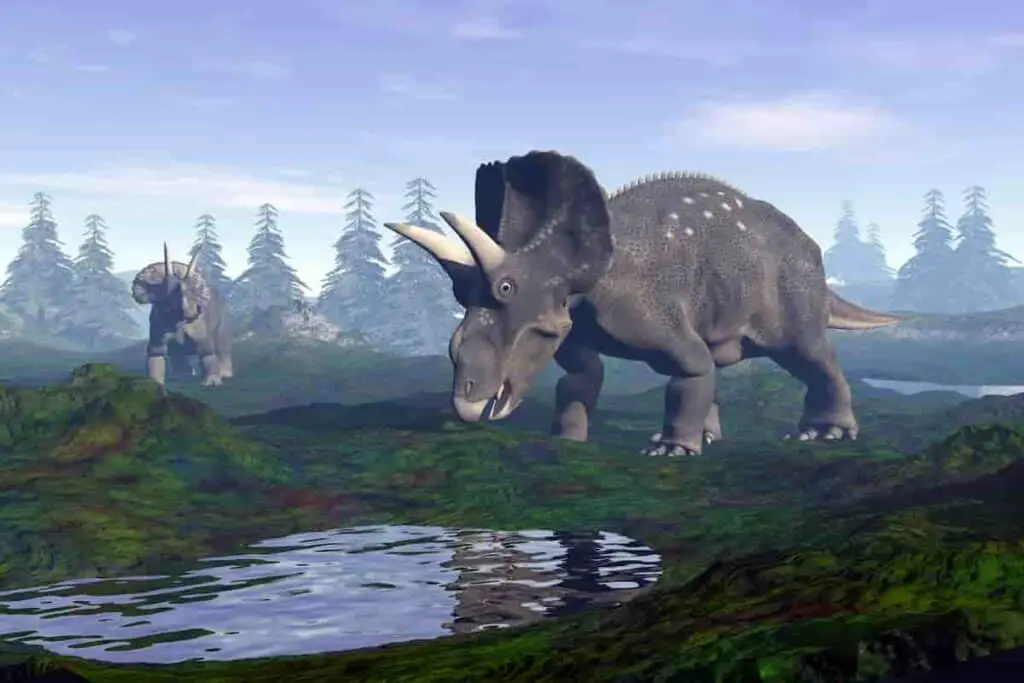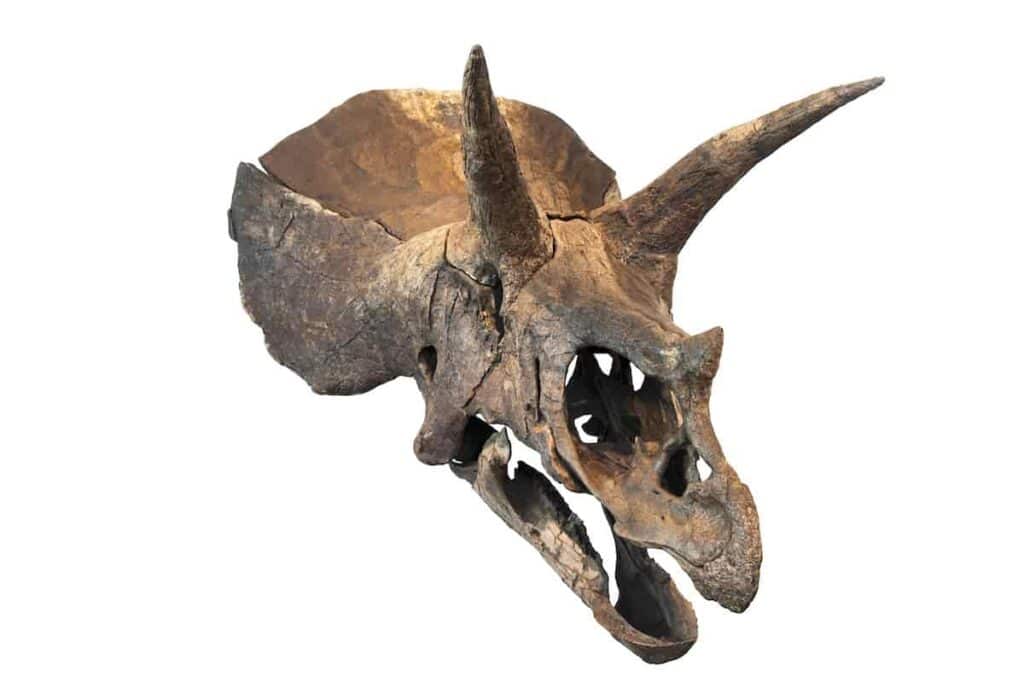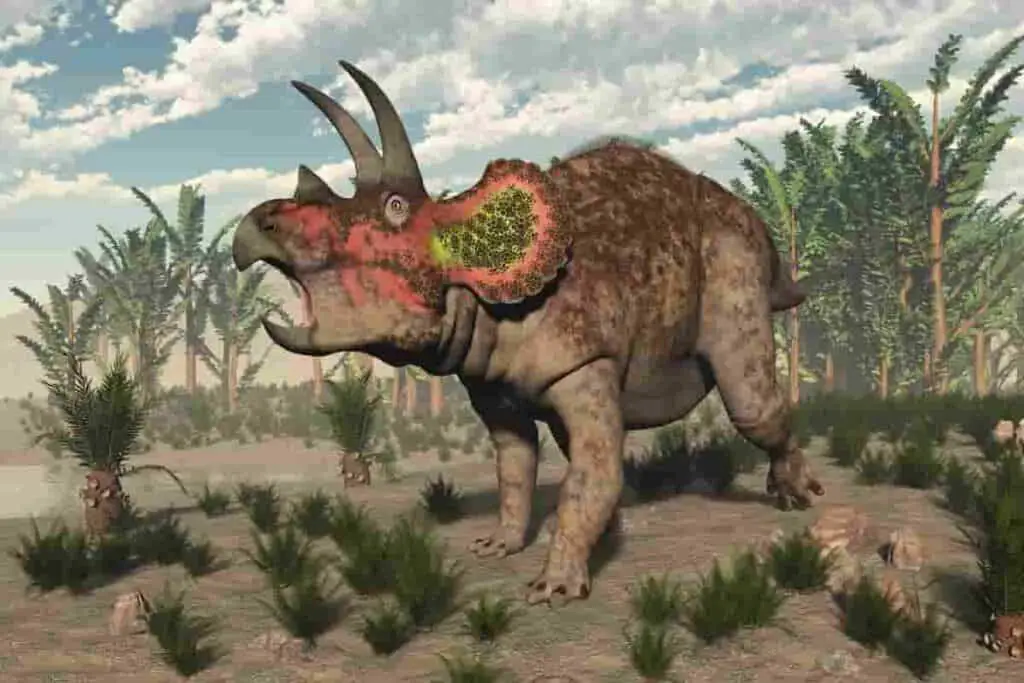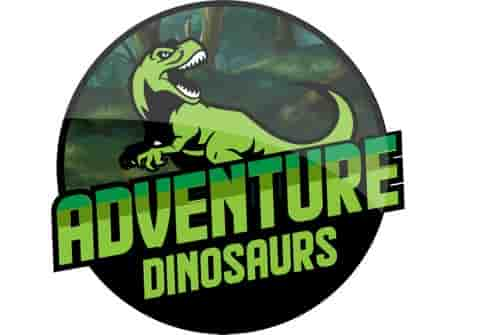The Triceratops is best remembered for its triple facial horns and huge skull frill protecting its neck, but this dinosaur species had some serious heft. Precisely how large was the Triceratops?

How Big Was a Triceratops?
The Triceratops was 26 to 30 feet long and stood nearly 10 feet tall. It was truly one burly dino, weighing between 13,000 and 26,000 pounds. For comparison, a city transit bus weighs about 26,000 pounds!
The Triceratops, a dinosaur species distinct for its size, marked its era in the Cretaceous period. This quadrupedal cretaceous giant showcased an impressive length of about 8 to 9 meters, setting it apart from many of its kind.
Contributing to its height and extraordinary weight of 6 to 12 tons were its sturdy skull and prominent horns, unique characteristics that made it one of the most recognizable of prehistoric beings.
Table of Contents
The fossils of this remarkable dinosaur, discovered and studied by dedicated paleontologists, have provided substantial information about its physical structure. The remarkable process of fossil analysis, even with its inherent challenges such as inconsistency in size and baseline preservation, continues to reveal insights into this dinosaur’s attributes.
Despite its strength and size, Triceratops, like its contemporaries, experienced extinction, its domination over the prehistoric landscape coming to an abrupt end. Today, the legacy of Triceratops endures, immortalized within the realms of paleontology, in museum exhibits around the world, and in the collective imagination of humanity, honoring the diverse life forms our planet once nurtured.
In the grand scheme of things, was the Triceratops a large dinosaur, especially compared to hadrosaurs or sauropods? What about compared to today’s animals? This article will answer those questions and more, so make sure you keep reading!
How Big Was a Full-Grown Triceratops?
Our knowledge of the Triceratops majorly expanded in 2006 when a study was published in the journal Proceedings of the Royal Society. The study was led by Mark Goodwin and John R. Horner, two paleontologists who studied Triceratops individuals closely.
The study categorized the dinosaurs into four unique ontogenetic groups: babies, juveniles, subadults, and adults. Goodwin, Horner, and their team reviewed 28 Triceratops skulls to categorize the dinosaurs accordingly.
According to the study, baby Triceratops skulls were about 15 inches or 38 centimeters long.
Juvenile Triceratops had a skull size that measured about 34 inches or 87 centimeters on the smaller side and up to 53 inches or 135 centimeters on the larger side.
Subadults, who were not quite mature but were close, had a skull size of about 63 inches or 160 centimeters. Some larger subadult Triceratops skulls, according to the study, measured 65 inches or 165 centimeters.
Adult Triceratops might have had a skull size of 82 inches or 208 centimeters through 88 inches or 225 centimeters.
Considering that adult Triceratops were 10 feet tall, up to 30 feet long, and could weigh 26,000 pounds, a skull size that largely makes sense for a mature dino.

How Big Was a Triceratops Compared to Other Dinosaurs?
We’ve made it clear that the Triceratops was a sizable dinosaur, but with at least 700 identified dinosaur species, how does the Triceratops measure up to others? This section will look at some amazing dinosaurs and answer that very question.
Stegosaurus
The Stegosaurus lived at least 150 million years ago during the Late Jurassic Period. It predates the Triceratops, which lived between 66 and 84 million years ago in the Late Cretaceous Period.
Known for its tail spikes and back plates, the Stegosaurus could reach lengths of 21 feet on average. Larger Stegosauruses could have reached sizes of 30 feet long. The dinosaur stood about nine feet on average.
Stegosauruses were no lightweights, as this herbivorous dinosaur weighed anywhere from 11,700 pounds to 15,400 pounds.
The Triceratops would have been moderately larger than the Stegosaurus when comparing lengths. The two dinosaur species, interestingly enough, were both the same height.
Lighter Triceratopses would have weighed about the same as a larger Stegosaurus, 13,000 pounds versus 15,000. A larger Triceratops that weighed 26,000 pounds would have had about 11,000 pounds on a Stegosaurus!
The two dinosaurs didn’t live in the same period, but they would have been competing for the same food sources if they had.
If you read another post on our blog on the Triceratops, you’ll recall how this dinosaur was a plant-eater, just like the Stegosaurus.
Brontosaurus
Let’s move from four-legged proto-ceratopsians and look at how a sauropod like the Brontosaurus would have measured up to the Triceratops.
The Brontosaurus–which means “thunder lizard” in Greek–was a quadruped sauropod that lived during the Late Jurassic Period just as the Stegosaurus did. Like both the Stegosaurus and the Triceratops, the Brontosaurus was an herbivore.
How big was it? The Brontosaurus measured 69 to 75 feet long. With its gargantuanly long neck, this was one tall dino, standing at a proud 80.3 feet. The neck alone was nearly 20 inches long!
A healthy adult Brontosaurus weighed 36,000 to 49,000 pounds.
The Triceratops cannot compare to the Brontosaurus. The dinosaur has less length, far less height at only nine feet tall, and even less weight.
The Brontosaurus weighed at least 10,000 pounds more than even the heaviest Triceratops but more like 23,000 pounds more.
Had the Brontosaurus and Triceratops lived during the same time, although they both would have fed on plant matter, they wouldn’t be eating the same food sources? The Brontosaurus could effortlessly reach treetops and feed up there while a Triceratops never could.
Although many would, not all sauropods would outsize a Triceratops. Sauropods are the group with the largest dinosaurs, after all.
However, as sauropods evolved, their necks shortened, significantly reducing their height.
Tyrannosaurus Rex
Is there a more famed dinosaur than the Tyrannosaurus Rex? We think not.
The T. Rex and Triceratops are about as different as can be, admittedly. Tyrannosaurus was a known ferocious meat-eater. It also walked on only two legs rather than four. However, both dinosaurs lived during the Cretaceous Period so they could have crossed paths.
Given that the dinosaur stood vertically rather than horizontally, T. Rex was only 40 feet long. The dino wasn’t all that tall either, measuring about 12 feet. This scary predator clocked in at 11,000 to 15,500 pounds.
The T. Rex was a slightly lengthier dinosaur than the Triceratops, even with its abbreviated length. The Tyrannosaurus also had a few feet of height over the Triceratops.
Larger Triceratops would have outweighed the T. Rex, which might have helped the former dinosaur species defend themselves against the latter if it ever came to that.
Parasaurolophus
The hadrosaurs were among the most plentiful and dominant plant-eaters in the Late Cretaceous Period. Prevalent across what is today North America and Asia, we thought we’d look at one hadrosaur in particular–the Parasaurolophus–and compare it to the Triceratops.
The Parasaurolophus, the “near-crested lizard,” sometimes walked on all four legs but could also walk on two like a T. Rex. This dinosaur species is best known for its protruding tube at the back of its head.
This dinosaur measured 33 to 36 feet long and stood at 16 feet tall. The Parasaurolophus weighed anywhere from 6,000 to 8,000 pounds.
The Parasaurolophus is only slightly longer than larger adult Triceratopses. It has a height advantage of seven feet.
We don’t think the Parasaurolophus would have had access to food that the Triceratops couldn’t reach even with that height advantage.
The Triceratops majorly outweighed the Parasaurolophus. If a Triceratops were 13,000 pounds, it’d be 5,000 to 7,000 pounds heavier. Bigger Triceratopses that were 26,000 pounds would outweigh the Parasaurolophus by 10,000 to 18,000 pounds.
Since they were both competing for the same food sources and lived simultaneously, this could have been the Triceratops’ advantage for survival.
Utahraptor
Let’s also compare the size of the Triceratops with that of the Utahraptor, a dromaeosaurid with a name that translates to “Utah’s predator.”
Alive during the Early Cretaceous Period in what is today North America, the Utahraptor was a carnivore that walked on two legs like the T. Rex.
The Utahraptor measured 16 to 23 feet long. It stood only 4.9 feet tall, which is the average height of some people today. The dino weighed 660 to 2,200 pounds.
The Utahraptor could have hunted the Triceratops; we don’t know for certain. The Utahraptor was shorter than the Triceratops, making it harder to reach the dino to take a fatal bite.
The Triceratops had thousands of pounds on the Utahraptor, well over 10,000 pounds. That would have put the Utahraptor at a disadvantage.
Remember that the Triceratops also had a skull frill and triple horns to protect themselves.
Velociraptor
Finally, we’ll examine another dromaeosaurid, the Velociraptor. This dinosaur lived towards the end of the Cretaceous Period and was a known carnivore. Most people are very familiar with this dinosaur species due to pop culture.
The Velociraptor was just six feet long, several feet tall, and perhaps 100 pounds. Thus, even if it had tried to attack the Triceratops as the Utahraptor might have, the Velociraptor would have been at an even greater disadvantage.

Which Is Bigger – an African Elephant or a Triceratops? And More Modern-Day Comparisons
We could compare the Triceratops to other dinosaur species all day. It’s quite fun and very interesting. You might be curious about how the Triceratops shapes up if you examine it besides today’s bigger creatures.
To wrap up, that’s exactly what we’ll do.
African Elephant
The African elephant includes the African forest elephant–which is smaller–and the bigger African bush elephant. These herbivores feature trademark grey skin but have varying skull sizes, ear shapes, and tusk colors.
We’ll look at the size of the larger African bush elephant. This animal reaches lengths of 24 feet in maturity and can stand 13 feet tall. Adult African bush elephants can weigh 6,600 to 13,000 pounds.
Curiously, the African bush elephant and the Triceratops are roughly the same lengths, with the dinosaur having a bit of a length advantage. The elephant is taller by four feet.
Although African bush elephants are considered enormous by today’s standards, the African bush elephant, at its biggest, would weigh the same as a Triceratops at its smallest, 13,000 pounds.
Dairy Cow
If you drink milk, eat cheese, or enjoy butter, yogurt, or ice cream, these products all come from dairy cows. These cows are surprisingly large animals, with an average body length of 92 to 103 inches.
A dairy cow in maturity can stand at 54 to 60 inches. They may weigh 1,400 to 2,000 pounds, so they’re quite big!
Dairy cows win in the length department compared to Triceratops. The dinosaur has several thousand more pounds than a dairy cow, and it’s somewhat taller.
Rhinoceros
The rhinoceros or rhino almost resembles a Triceratops with its facial nose horns. Despite that, rhinos aren’t in the slightest related to dinosaurs.
The rhino measures 11 to 13 feet long and stands between 59 and 69 inches tall. An adult rhinoceros might weigh 1,900 to 3,500 pounds. Males always outsize females.
Rhinos are imposingly large creatures, but they weigh less than an average adult Triceratops did. Further, the Triceratops has a lot more length and height.
German Shepherd
How about we look at man’s best friend? The German Shepherd is a large dog breed, but just how large is it when stacked against the Triceratops?
Adult German Shepherds have a body length of 22 to 26 inches. The dog stands maybe 26 inches tall, especially males. Their weight is anywhere from 71 to 88 pounds.
This one is a no-contest, as a Triceratops is bigger.
Conclusion
The horned dinosaur Triceratops was far from the largest dinosaur that roamed during the Late Cretaceous Period, but it wasn’t the smallest. When going up against tinier predators, a Triceratops could have used its bulk and its horns for protection.
We hope you enjoyed this glimpse into the Triceratops!
